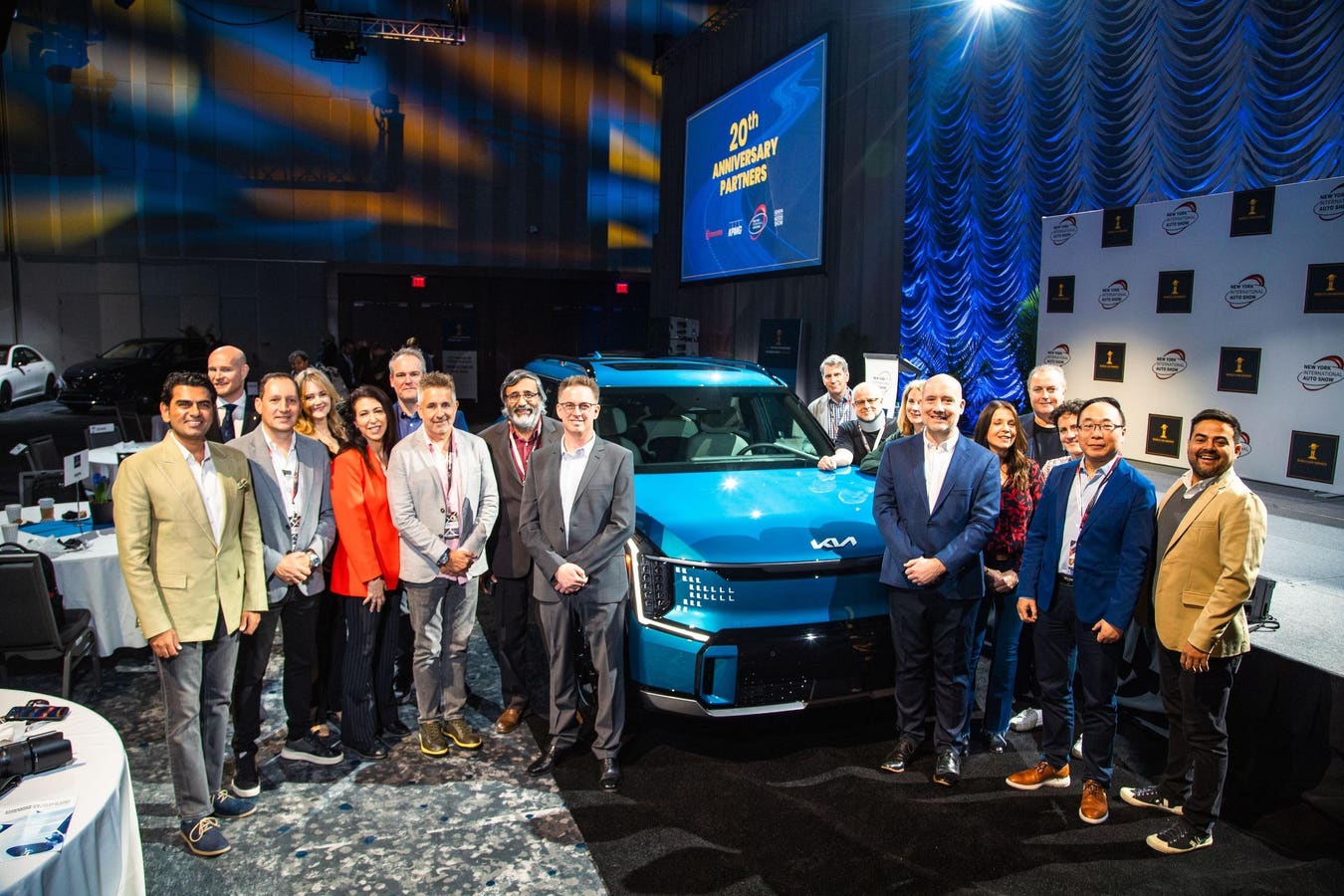
The 2024 World Car Awards were announced last week during the New York International Auto Show. It was a good day for Kia, with its three-row, all-electric EV9 winning both the World Electric Vehicle and the overall World Car of the Year (WCOTY) title. It was an even better day for alternative fuel vehicles, with every category winner powered by something other than a traditional internal combustion engine. The BMW 5 Series/i5 won World Luxury Car, Hyundai’s Ioniq 5 N won World Performance Car, Volvo’s EX30 won World Urban Car, and the Toyota Prius won World Car Design of the Year.
SangYup Lee and Jose Munoz post with triple-winning 2023 Hyundai Ioniq 6
C Squared Photogrphy for WCOTY
This was the second year in a row for an all-alternative fuel sweep. Last year’s World Car Awards gave a triple-win to the Hyundai Ioniq 6 (World Electric Vehicle, World Car Design of the Year, and overall 2023 WCOTY), plus the Lucid Air (World Luxury Car), KIA EV9 GT (World Performance Car) and Citroen C3 (World Urban Car). Admittedly, the Citroen C3 was primarily evaluated on its internal combustion models offered in India and Latin America. But an all-electric C3 debuted ahead of the 2023 WCOTY awards, no doubt adding to its appeal with jurors.
Consistent electric vehicle wins over the past 2 years suggest EVs are the obvious wave of the future, but does the market agree?
The 2024 Hyundai Ioniq 5 N puts the fun in electric vehicle functionality
WCOTY
As a member of the World Car of the Year jury I can attest to awarding points to all of these winners. The KIA EV9 is an impressive combination of space-efficient packaging, cool design, premium interior treatments, and capable performance. The Hyundai Ioniq 5 N is a shockingly (yes, I’m using that word) fun car to drive, and the Volvo EX30 offers strong value. The BMW 5 Series comes in EV form (i5) while retaining what makes the 5 Series so engaging, and the new Toyota Prius’ styling, driving dynamics, and fuel efficiency have me seriously considering a purchase.
Volvo EX30 during World Car of the Year testing
WCOTY
Electric vehicles are winning awards beyond the WCOTY, with the Kia EV9 winning 2024 North American Utility Vehicle of the Year (I’m on that jury, too), the Lucid Air among Car and Driver’s Top 10 for 2024, and the Chevrolet Blazer EV named 2024 Motor Trend SUV of the Year. Clearly electric vehicles have achieved popularity with the automotive experts who decide these things. So why are EVs stacking up on dealer lots as sales plateau and manufacturer’s cut electric vehicle production? And why, at the same time, are hybrids selling better than ever?
EV market share grows quickly…as long as it’s below 8 percent
iSeeCars.com
My theory is that about 8 percent of the consumer market is ready for electric vehicles today. This statement is backed by a recent iSeeCars study that showed cities and states (i.e. California, Oregon, and Washington) with more than 8 percent EV share are among the slowest in growing EV share, while regions with less than 8 percent EV share are growing it much faster. And now that we’ve reached roughly 8 percent national EV market share we’re seeing a national plateau in EV sales. Maybe not-so-coincidentally, we’re also seeing a big drop in both new and used EV prices.
Electric vehicles are leading the way in lost value after one year
iSeeCars.com
At the same time, we’re also seeing as much or more interest in hybrid vehicles than we’ve ever seen. Consider that our latest iSeeCars study shows 6 electric vehicles out of the 10 models that lost the most value after one year. The same study shows 5 hybrids out of the 10 models that held their value the best after one year. Did I mention how much I really like the 2024 Toyota Prius? That car won North American Car of the Year and Motor Trend Car of the Year for 2024, and it’s on Car and Drivers latest Top 10 list.
Hybrids are among the strongest vehicles for retained value after 1 year
iSeeCars.ocm
Many people forget that Honda introduced the first hybrid vehicle to U.S. consumers with its 2000 Honda Insight. I was at Edmunds 24 years ago, and we named it the Most Significant Car of the Year (Edmunds’ version of car of the year back then). The Insight got passed over by most automotive publications, and consumers, as little more than an exotic exercise in fuel efficiency — a title it earned with a 70 mpg EPA rating. But I saw it as a preview of coming attractions, and Toyota proved me right four years later with an all-new Prius that resonated with both journalists and consumers.
The Honda Insight hybrid was Edmunds’ Most Significant Vehicle of the Year 24 years ago
Edmunds.com
Now, 24 years later, consumers have embraced the concept of both hybrid and plug-in hybrid drivetrains. They understand the benefits of higher fuel efficiency (or even zero fuel use with plug-in models that operate as EVs for 20-50 miles) while never experiencing range anxiety or forced public charging challenges from an infrastructure not ready for mass EV adoption.
Toyota Prius, Volvo EX30 and Kia EV9 during World Car of the Year testing
WCOTY
The electric vehicle revolution is trying to happen, and it’s generating a lot of headlines. But while automotive journalists and mainstream news outlets focus on EVs, hybrids are winning over mainstream consumers, including yours truly. They are also substantially reducing gasoline use and CO2 emissions. They say the best diet and the best workout regimen are the ones you can stick to. I would add, the best cars to save the planet are the ones you can sell.
